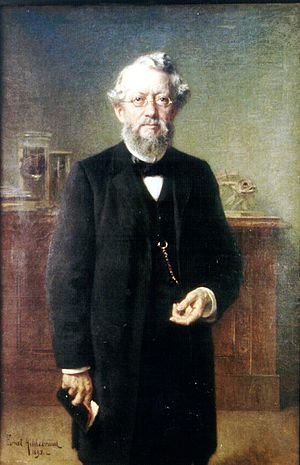Karl Möbius facts for kids
Quick facts for kids
Karl August Möbius
|
|
|---|---|

Portrait by Ernst Hildebrand (1895)
|
|
| Born | 7 February 1825 |
| Died | 26 April 1908 (aged 83) |
| Citizenship | German |
| Alma mater | Humboldt University University of Halle |
| Known for | Biocoenosis, ecology of oysters |
| Scientific career | |
| Fields | Zoology, ecology |
| Institutions | University of Kiel Natural History Museum of Berlin |
| Doctoral students | Bernhard Tollens |
Karl August Möbius was a German zoologist born on February 7, 1825, in Eilenburg. He passed away on April 26, 1908, in Berlin. Möbius was a very important scientist who helped start the study of ecology. He also used to be the director of the Museum für Naturkunde in Berlin.
Contents
Early Life and Education
Möbius grew up in Eilenburg, which is in Saxony. He started primary school when he was just four years old. At age 12, his father sent him to train as a teacher.
In 1844, he finished his teacher training with excellent results. He then began working as a teacher in Seesen. In 1849, a famous scientist named Alexander von Humboldt encouraged him. Möbius then started studying natural science and philosophy in Berlin.
After he graduated, Möbius taught many subjects. From 1853 to 1868, he taught zoology, botany, mineralogy, geography, physics, and chemistry. He taught these subjects at the Gelehrtenschule des Johanneums in Hamburg.
Research on Oysters and Ecology
In 1863, Möbius opened Germany's first sea water aquarium in Hamburg. This was a big step for studying marine life. In 1868, he earned his doctorate from the University of Halle. Soon after, he became a Professor of Zoology at the University of Kiel. He also became the director of the Zoological Museum there.
Möbius was very interested in marine animals. His first big work was about the animals in the Kieler Bucht. This work, called Die Fauna der Kieler Bucht, focused on how animals interact with their environment.
Studying Oyster Beds
Between 1868 and 1870, Möbius was asked to study oyster beds in the Bay of Kiel. At that time, oysters were very expensive. Only wealthy people could afford them. When railroads made it easier to transport goods, the demand for oysters grew a lot. The government wanted to know if they could get even more oysters from the beds.
Möbius's research led to two important books. In these books, he explained that farming oysters in Northern Germany was not a good idea. But more importantly, he carefully described how different living things in an oyster bed work together. He even created a new word for this: "biocenose". This word is still used today in community ecology, which studies how groups of living things interact.
Later Career and Legacy
In 1888, Möbius became the director of the Zoological Collections. These collections were at the Natural History Museum of Berlin. He also became a professor at the Kaiser Wilhelm University, Berlin. He taught systematic and geographical zoology there until he retired in 1905. He was 80 years old when he retired.
Throughout his life, Möbius supported education. He helped places like the Berlin Urania. He wanted to share knowledge about natural sciences with everyone. His work helped us understand how living things depend on each other in their natural homes.
See also
 In Spanish: Karl Möbius para niños
In Spanish: Karl Möbius para niños

